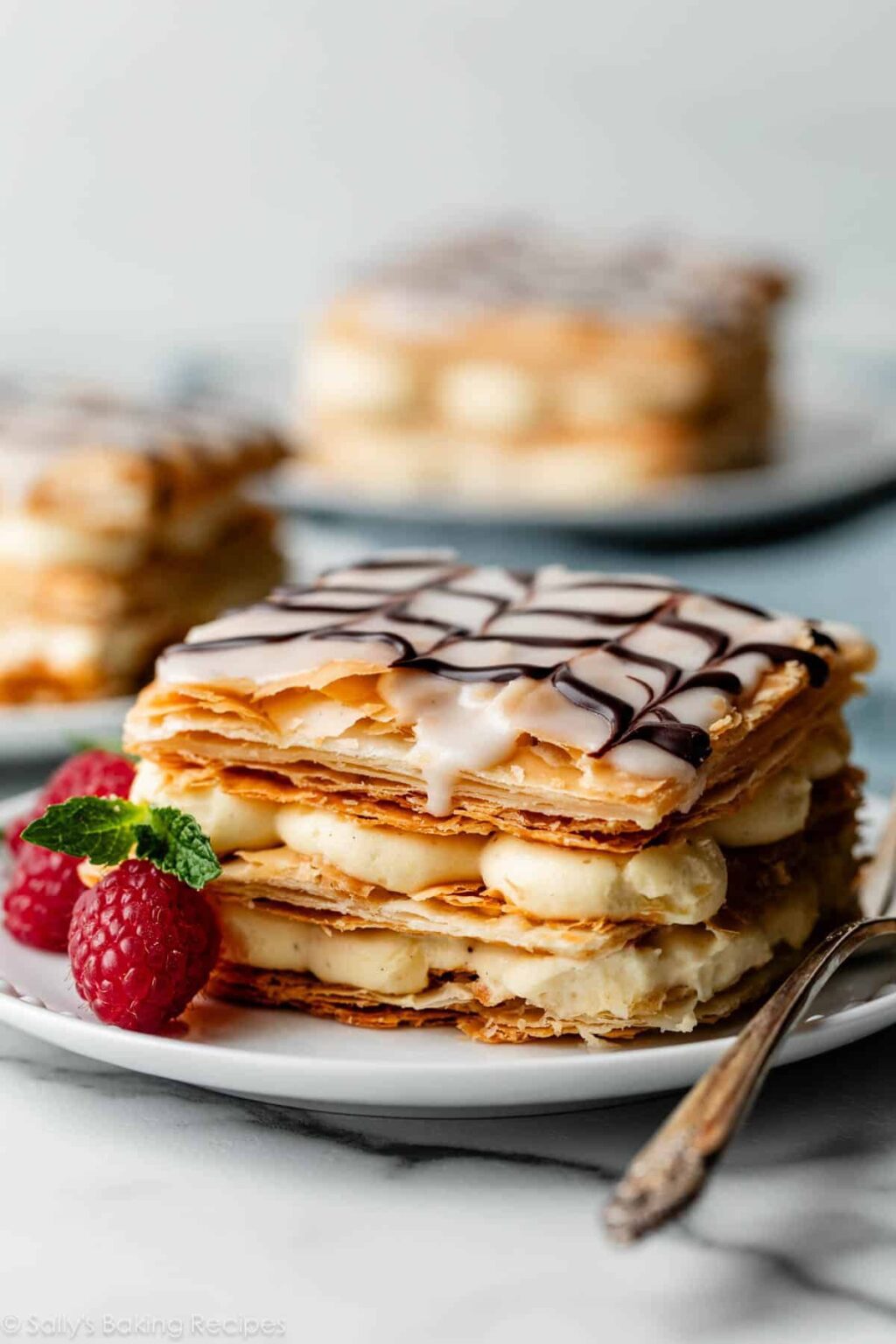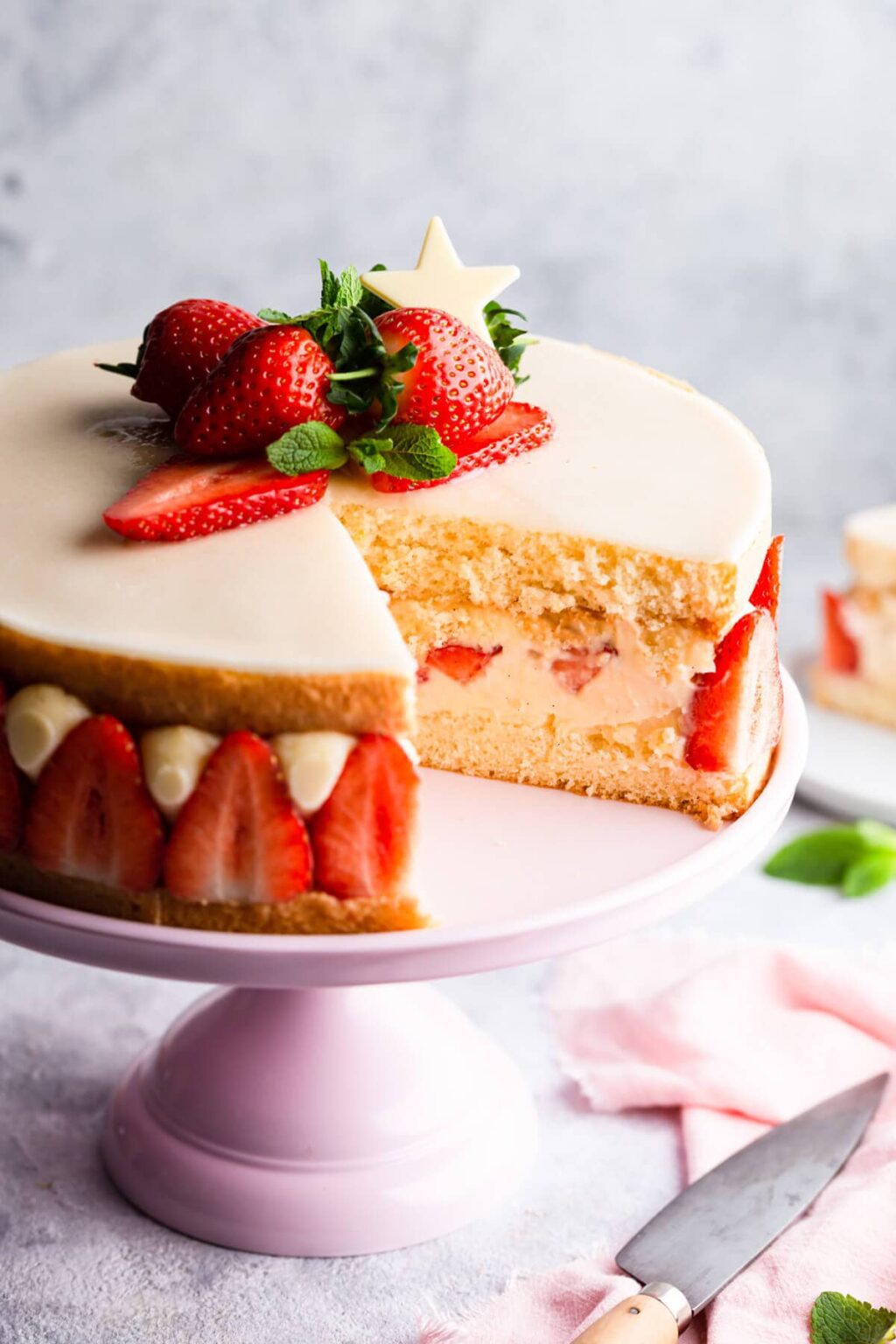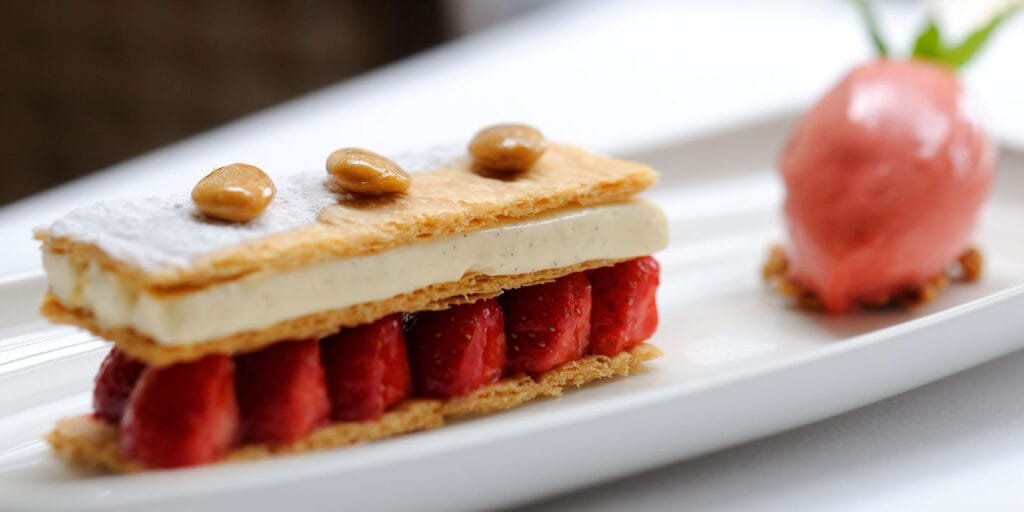French cuisine is synonymous with elegance, and its desserts are no exception. These culinary masterpieces are crafted with high-quality ingredients and meticulous techniques, resulting in a symphony of flavors and textures. From creamy custards to flaky pastries and vibrant compotes, traditional French desserts have been captivating palates for centuries.
Rooted in rich history, French desserts have evolved through the ages, reflecting regional influences and cultural exchanges. The term “pâtissier” itself, referring to a pastry chef, originates from French. France’s dedication to the art of dessert is further solidified by its world-renowned patisseries, offering an endless array of delectable treats.
So, if you have a sweet tooth and appreciate the finer things, then delve into the world of traditional French desserts. Get ready to embark on a delightful journey through iconic creations like the Mille-Feuille and the Macaron, each a testament to France’s culinary artistry and heritage.
1. Crème brûlée
Crème brûlée is a classic French dessert renowned for its rich and creamy vanilla custard, topped with a caramelized sugar crust that adds a delightful contrast of textures. This indulgent treat is best enjoyed cold, offering a simple yet exquisite flavor experience.

The origins of crème brûlée can be traced back to the 17th century, as documented by François Massialot in 1691. It is believed to have been influenced by the Spanish dish, crema catalana. Despite fading in popularity for a time, crème brûlée experienced a resurgence in the 1980s and has since become a staple of French dessert culture.
The allure of crème brûlée lies in its velvety smooth custard and the satisfying crackle of its caramelized sugar topping. This French dessert has stood the test of time, earning its place as a beloved delicacy worth savoring.
2. Soufflé
The soufflé, a beloved traditional French dessert, is a versatile dish that can be enjoyed in both sweet and savory variations. Its signature characteristic lies in its lofty rise, achieved by incorporating whipped egg whites into a base mixture typically consisting of crème pâtissière. During baking, the trapped air within the mixture expands, causing the soufflé to puff up impressively.

Renowned for its light and airy texture, the soufflé retains a creamy, indulgent center, making each bite a decadent delight. This iconic dessert is often served hot, straight from the oven, ensuring that its delicate structure is at its peak.
The origins of the soufflé are credited to Vincent La Chapelle, a master pâtissier of the early eighteenth century. Initially conceived as a dessert, the soufflé has since become a staple in French culinary repertoire, with popular flavors including chocolate and lemon. To enhance the experience, sweet soufflés are typically accompanied by delectable additions such as crème anglaise, cream, or ice cream.
3. Macarons
Macarons, a quintessential traditional French dessert, have gained a reputation as one of the most stylish delicacies in culinary culture.

These delicate biscuits are crafted from whipped egg whites, resulting in a light, almond-flavored treat reminiscent of meringue. With their characteristic round shape and airy texture, macarons are often filled with flavored ganache and come in a myriad of colors and flavors, gracing the tables of upscale cafés and patisseries.
4. Mille-feuille
Mille-feuille, a beloved traditional French dessert, boasts a name that translates to “cake of a thousand sheets.” While the actual layer count is closer to three, this pastry delivers a textural symphony. Flaky puff pastry forms the base, separated by layers of rich crème pâtissière. The masterpiece is often finished with a royal icing glaze and marbled chocolate, making it a feast for both the eyes and the palate.

Mille-feuille’s origins date back to the 18th century, appearing in a French recipe book in 1733. Its popularity soared during the Napoleonic era, becoming a staple in Parisian patisseries. This iconic dessert is thought to be the inspiration for many other “stacked bakes” solidifying its place as a cornerstone of traditional French desserts.
5. Tarte Tatin
Tarte Tatin, a jewel in the crown of traditional French desserts, offers a delightful twist on the classic fruit tart. This upside-down masterpiece features a base of buttery pastry topped with a crown of caramelized apples.

The magic happens during baking, as the apples are first cooked until golden and gooey, creating a sticky, sweet base. Then, the pastry is layered on top, and the entire dish is baked to perfection. Upon flipping the pan, the tart reveals a stunning presentation of caramelized apples, a signature element of this beloved dessert.
The origins of Tarte Tatin are as charming as the dessert itself. In the 1880s, the Tatin sisters, proprietors of a hotel, are said to have accidentally created this masterpiece. Legend has it that Stéphanie Tatin overcooked the filling for an apple pie. In a resourceful attempt to salvage the dish, she simply placed pastry on top of the caramelized apples and baked it. This “mistake” resulted in a surprise success, solidifying Tarte Tatin’s place as a beloved traditional French dessert.
6. Madeleines
Madeleines, miniature masterpieces of French cuisine, are a delightful option for those seeking a quick and elegant sweet treat. These bite-sized cakes are crafted from a genoise batter, delicately flavored with ground almonds, and baked in charming shell-shaped molds.

Madeleines hold a special place within the world of traditional French desserts. Their origins, however, remain shrouded in a bit of mystery. Hailing from the Loraine region of France, these delectable morsels boast several competing creation stories. A popular tale links their unique shape to pilgrims on their journey to Santiago de Compostela in Spain.
7. Profiteroles
Profiteroles, also known as choux à la crème, are a beloved indulgence in the world of traditional French desserts. These delightful pastries feature light and airy choux pastry puffs, baked until perfectly hollow. Once cooled, they are filled with a decadent cream or custard, often piped in for a smooth and satisfying texture. The finishing touch? A rich drizzle of melted chocolate, transforming them into miniature masterpieces.

Profiteroles boast a surprisingly royal history. Invented by the head chef to Catherine de Medici upon her marriage to King Henry II of France in the 16th century, these light puffs quickly became a favorite of the Queen. Over the following centuries, the recipe evolved as pastry chefs honed their craft. Traditional French desserts like profiteroles benefited from this continuous refinement, reaching their current form in the late 1800s thanks to the culinary genius of Marie-Antoine Carême. Since then, profiteroles have remained a staple on French dessert menus, a testament to their enduring appeal.
8. Paris-Brest
Paris-Brest, a true champion among traditional French desserts, pays homage to the famed cycling race between Paris and the Breton city of Brest. This visually striking pastry embodies the spirit of the race with its distinctive wheel shape, crafted from a large choux pastry ring.

The magic unfolds when the ring is sliced in half, revealing a delectable praline cream filling. The contrasting textures – the light and airy choux pastry against the smooth and nutty praline cream – create a delightful flavor explosion in every bite. A sprinkle of powdered sugar and a crown of sliced almonds add the finishing touch, transforming this dessert into a masterpiece of both taste and presentation.
Paris-Brest transcends its celebratory origins, becoming a beloved symbol of French culture and culinary creativity. It’s a testament to the ingenuity of French pastry chefs, who have consistently pushed the boundaries of dessert design and flavor with their traditional French desserts.
9. Fraisier
Fraisier, a cherished traditional French dessert, derives its name from the French word for strawberries, “fraise.” This iconic delicacy comprises two layers of delicate génoise sponge cakes, generously filled with creamy crème mousseline pastry cream and adorned with fresh strawberries encircling the cake. A delicate layer of marzipan crowns the top, adding a subtle almond flavor to the ensemble.

A feast for both the eyes and the palate, the fraisier epitomizes elegance and sophistication in French patisserie. Its presence in bakery windows signals the arrival of strawberry season, inviting indulgence in this exquisite treat. While variations of the fraisier may boast intricate piping and fruit gelée, it is the vibrant, fresh strawberries that truly steal the spotlight, elevating this traditional French dessert to culinary perfection.
10. Cherry Clafoutis
Clafoutis, a cherished member of the traditional French dessert family, is a testament to the transformative power of simple ingredients. This baked dessert features fresh fruit nestled in a light, custard-like batter, allowing the natural flavors to take center stage. While cherries are the most common filling, clafoutis welcomes a variety of seasonal fruits, such as raspberries, plums, apricots, and apples.

The beauty of clafoutis lies in its simplicity. A basic batter, consisting of eggs, flour, milk, sugar, vanilla, and butter, forms the base. Fresh fruit is arranged in a buttered baking dish, ready to be embraced by the batter. As the clafoutis bakes, the batter sets into a flan-like custard, creating a warm and comforting dessert.
Clafoutis exemplifies the essence of traditional French desserts – taking a handful of high-quality ingredients and transforming them into a culinary delight. It’s a testament to the French reverence for fresh, seasonal produce and their dedication to crafting simple yet elegant desserts.
11. Ile FLottante
Ile Flottante, also known as “floating island” is a whimsical and delightful member of the traditional French dessert family. This ethereal dessert lives up to its name, featuring a light and airy meringue that seems to float on a pool of creamy custard. Often called “œufs à la neige” (eggs in snow), it was a favorite of the renowned chef Julia Child, and for good reason.

The meringue, the star of the show, is crafted by gently whisking egg whites with sugar until they reach a frothy consistency. This airy mixture is then baked at a high temperature for a short time, resulting in a smooth, tender, and silky texture. A pool of cool and creamy crème anglaise (vanilla custard) serves as the base for this dreamy island.
For an extra touch of elegance, a drizzle of rich caramel or a sprinkle of toasted and candied nuts adds a delightful textural contrast. With its simple yet stunning presentation and focus on fresh ingredients, Ile Flottante perfectly embodies the spirit of French desserts. It’s a guaranteed crowd-pleaser, offering a delightful escape into a world of light and airy sweetness.






